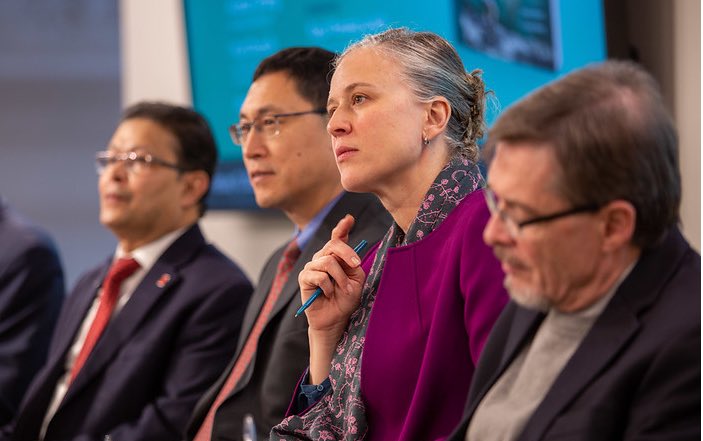For decades, high fish prices contributed to poor nutrition in Bangladesh, placing a key source of protein and other nutrients effectively out of reach to many. But the recent expansion of aquaculture has lowered fish prices and boosted fish consumption, helping Bangladesh to draw nearer to Sustainable Development Goals 1 and 2 (ending poverty and hunger by 2030). This turnaround was so dramatic and unexpected that it has gained the nickname “Blue Revolution.”
A new IFPRI book, The Making of a Blue Revolution in Bangladesh: Enablers, Impacts and the Path Ahead for Aquaculture, outlines what brought about these changes, their implications for poverty and welfare, and the future prospects for aquaculture. At a Feb. 11 book launch, four of the book’s contributors provided key insights from their findings that can help shape future agriculture transformations in Bangladesh and around the world.
Fish play an increasingly prominent role in global diets, said co-editor and IFPRI South Asia Director Shahidur Rashid. “Globally, fish account for 20% of animal source protein consumed by humans and fish is the fastest growing food sub-sector in the world,” he said. Thus, ensuring sustainable growth and development of the fish sector is crucial to alleviate poverty and hunger around the world.
Understanding the enablers of Bangladesh’s successful Blue Revolution can help influence and shape future food sector transformations, noted World Bank economist Loraine Ronchi. Bangladesh’s aquaculture sector has undergone five transformations, according to co-editor Xiaobo Zhang: Extensive growth, intensification, commercialization, formation of fish clusters, and spatial concentration. Fish clusters are particularly advantageous, he said, because they facilitate communication, competition, and collaboration between fish farmers, leading to increasing innovation and adoption of modern technology.
Bangladesh’s aquaculture transformation was largely driven by increased domestic demand fueled by rising incomes, Zhang said. Improved technology, reduced transaction costs, and value-chain innovation also contributed. For example, the country’s rural road building program enabled more efficient transportation from fish farms to retail markets.
Studies conducted early in Bangladesh’s aquaculture transformation cautioned that growth in the industry could increase inequality. But aquaculture has had a positive effect on the welfare of all income groups, explained IFPRI Senior Research Fellow Nicholas Minot, a co-author. The combination of rising income levels and lower prices and transaction costs increased fish consumption more equitably than expected.
From 2000 to 2010, aquaculture accounted for 2.11% of Bangladesh’s annual income growth and 1.7 percentage points of overall poverty reduction. National poverty rates declined from 48.9% to 31.5%—17.4 percentage points—in that time frame. “The growth of aquaculture by itself accounted for roughly 10% of the poverty reduction —the fairly impressive and dramatic poverty reduction— that occurred over those ten years,” Minot noted.
Despite the progress of the last two decades, Bangladesh’s full potential for growth in aquaculture productivity has yet to be realized, Rashid said. But with per capita consumption at a historic high, can domestic demand continue to fuel aquaculture growth?
Given increased aquaculture investment and productivity, fish production will continue to grow through 2030 and will likely outpace demand, said co-author Paul Dorosh, Director of IFPRI’s Development Strategy and Governance Division. Total fish production is estimated to reach almost 7 million metric tons, which will reduce prices and improve fish accessibility for poor households, he said.
Aquaculture in Bangladesh appears to have a bright future, Rashid said—thus it is imperative for the government to continue fostering the industry’s momentum. For instance, farmers’ risks should be reduced by strengthening credit and insurance institutions, and regulation and political institutions should be improved so Bangladesh can more effectively integrate into international markets. Finally, Rashid suggested closing the existing research gap around aquaculture’s environmental sustainability and climate resilience.
Ronchi applauded the book for shedding light on Bangladesh’s aquaculture transformation and the lessons it can provide. “This book is important for other countries looking for lessons on how to transform their aquaculture,” she said. “But from a policy perspective, it’s also important to Bangladesh itself that it learns from its own success here—to do the same with the sector and food diversification that it’s striving towards.”
Julia Wilson is an IFPRI Communications Intern.







